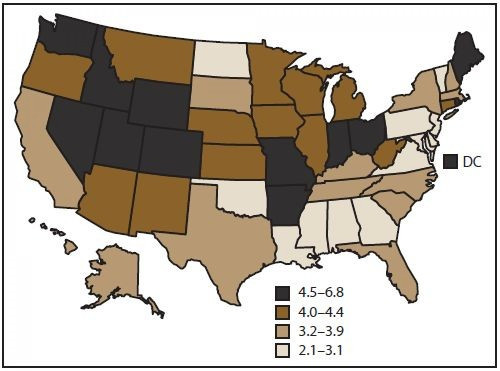CDC Examines Suicidal Thoughts State by State

Over eight million American adults had suicidal thoughts between 2008 and 2009, a period during which an estimated one million adults attempted suicide, according to a study released Thursday.
The study gave policy and suicide prevention experts a first look into the prevalence of suicidal thoughts and intentions at a state-by-state level from researchers for Centers for Disease Control and Prevention.
State residents widely ranged in suicidal thoughts or attempts. Utah topped the list of residents with serious thoughts of suicide (6.8 percent) with Georgia at the bottom (2.1 percent). In terms of suicide attempts, Georgia also was at the bottom of the list, shared with Delaware (0.1 percent) while Rhode Island had the highest frequency (1.5 percent).
Richard McKeon, chief of the suicide prevention branch with the Substance Abuse and Mental Health Services Administration, called the study a major step forward, a first time look at the magnitude of the number of suicide attempts.
The 1.1 million estimated suicide attempts between 2008 and 2009 were higher than what experts had previously thought, McKeon said, who attributed that to an undercount in emergency rooms where survivors may not be properly coded as people who attempted suicide.
(The survey) gives us another tool to measure the impact of our efforts and that's important, McKeon said.
The researchers remained puzzled why the rates of suicidal thoughts differed among states.
We don't know exactly why a given state might be very different than its neighbor, said lead author Alex Crosby, a medical epidemiologist in the division of violence prevention at the National Center for Injury Prevention and Control. This does give us information about the focus on vulnerable groups that we can now start working on.
Younger people tended to have more suicidal thoughts, and females reported more suicidal thoughts, but no gender differences were found in suicidal plans or attempts.
People who have risk factors for suicidal behavior, such as clinical depression, may migrate to a certain area, the study suggests. Is it possible that there's a large move of people with clinical depression to one part of the country? Crosby said.
The results came from a National Survey on Drug Use and Health survey that included 92,264 respondents aged 18 or older between 2008 and 2009.
The study broke the country down by geographic regions: adults in the West, Northwest and Midwest tended to consider suicide more than residents in the Southeast or Northeast.
Suicide is a preventable tragedy, Pam Hyde, administrator of the Substance Abuse and Mental Health Services Administration, which collaborated with the CDC on the new study, said in a statement. With this new data we will be able to work more effectively to reach people at risk and help keep them safe.
The researchers said they hoped the new results will allow suicide prevention programs to become tailored to the geographic region.
Multiple factors contribute to risk for suicidal behavior. The variations identified in this report might reflect differences in the frequency of risk factors and the social and economic makeup of the study populations, Linda C. Degutis, director of CDCs National Center for Injury Prevention and Control said in a statement. These differences can influence the types of prevention strategies used in communities and the groups included.
The CDC recommends that anyone having suicidal thoughts call the National Suicide Prevention Lifeline at 1-800-273-8255.
© Copyright IBTimes 2024. All rights reserved.





















